What is effective teamwork?
Effective teamwork is the crucial ingredient of successful businesses. Smooth processes within teams and harmonious relationships between co-workers increase productivity, generate better ideas and a more pleasurable work environment, and tackle any challenges more successfully. In the long run, these significantly increase the chances for the company to thrive in the market.

Putting together a team of people might not be too difficult, but fostering productive teamwork requires a whole different set of skills. If you’ve ever been a member of a couple of teams (your answer is probably yes), you’ve undoubtedly noticed how every group of people is different. Some teams breeze through difficult tasks with ease, while others stumble or even fail to deliver. Carl Pullein, a team productivity expert shared some interesting tips and tricks on this matter in one of the In The Loop Podcasts:
Why is that? What are the factors that influence teamwork effectiveness and foster thriving collaboration?
We’ve spent many hours answering these questions when creating our teamwork platform, Loop Email. Theoreticians of organizational behavior have spent years studying teams and putting their observations into various teamwork effectiveness models, so there was plenty to read!
In this blog, we’ve decided to combine the theory with practice; the latter coming from real-life experiences of successful businesses. By talking to great teams and their leaders, we’ve put together
Setting goals and objectives – and then communicating them to your team
HACK #1: Setting the right goals.
Ayetkin Tank from JotForm finds that the main teamwork hack is for the team to look in the same direction:
The big thing for JotForm has been focus. We rally entire teams, oftentimes the entire company, around a single goal — whether it’s a new product, a feature, a metric, whatever. And in doing that we foster an environment that’s incredibly collaborative, ruthlessly efficient, and more productive than ever. – Aytekin Tank, JotForm
That’s why the first hack focuses on setting the right goals. Firstly, make sure your goals are SMART. If they don’t do not check all the requirements,
After you have carefully and thoughtfully defined the vision, mission, and the goals, make sure to stand behind it. Consistency is key because frequent shifts in direction can confuse your team. They can lead to misunderstandings, loss of focus, and send effective teamwork down the drain.
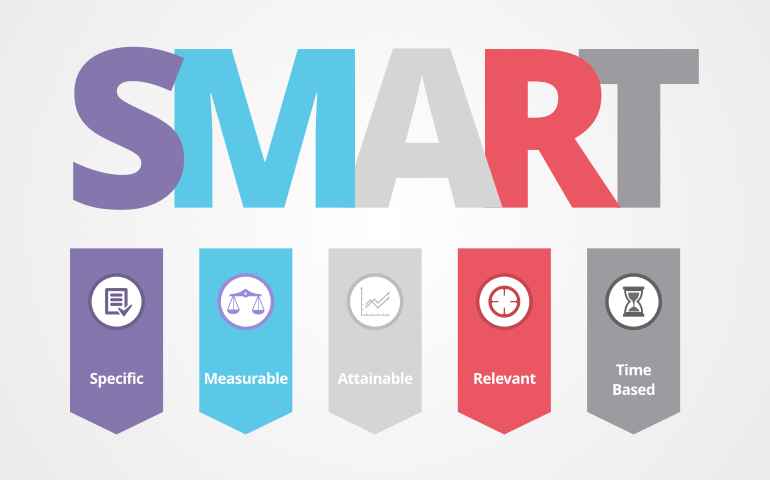
HACK #2: Make your goals visible at all times.
However, unless you share your business goals with your team, people are left in the dark. The big picture of your business efforts should be in front of your teammates’ eyes often. Explain, underline, evangelize the goal. One great way is to write it on the wall or a whiteboard in the common area or someplace people can see it when they work.
HACK #3: Use different types of communication
Don’t forget that people listen, hear and understand messages in different ways, so mix up the ways you use to communicate the vision. Besides writing it on the wall, present it in the company’s weekly meeting, send an email with bullet points, include it in face-to-face meetings and performance evaluations. Find the way that works for your team.
Take advice from Jan Krieger:
I had an announcement that needed to go to a broad audience of people. I was concerned about how likely it was that the information would be read, much less retained, so I asked for advice from an internal communication specialist. Her advice: Expose people to at least three different methods of communication. This will help them retain and possibly understand what you are trying to communicate. Don’t make the mistake of sticking to one method.” – Jen Krieger, Red Hat
HACK #4: Track team goals in real-time
Reaching a milestone is a big motivation boost for everyone. With all the tools available in 2019, it’s increasingly easy to share progress with people. Use roadmaps, publish them on a big screen or give access to them online so that everyone can check on them at any time.
Find and download a roadmap template for your business
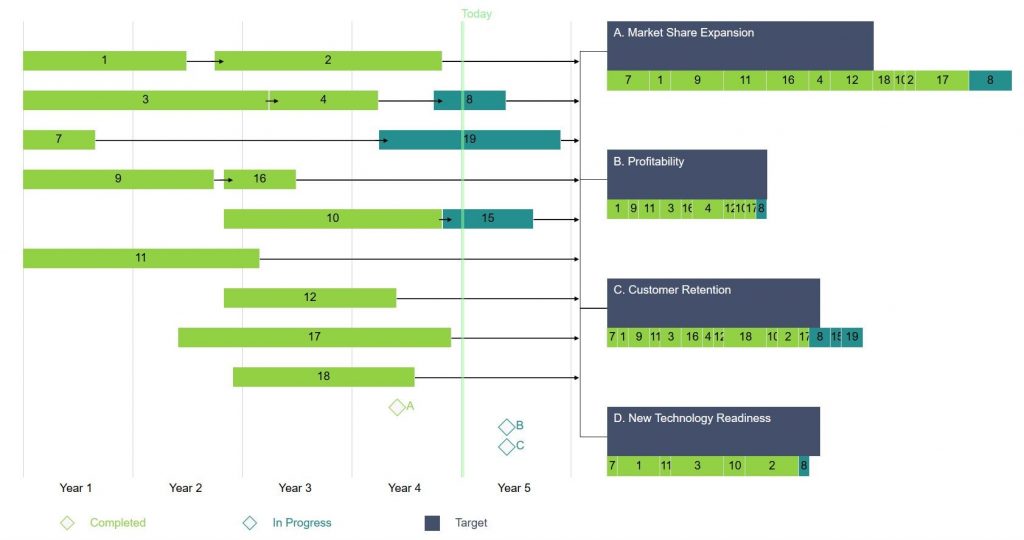
HACK #5: Break the goal into smaller chunks
A big, ambitious goal can be paralyzing. Make it easy to digest and break it up in weekly plans and goals.
A good practice we have in our LOOP office is setting and sharing weekly goals every Monday – our team leader sends out an email with bullet points that sum up the key goals we are aiming to achieve by Friday. He then checks on the progress mid-week, syncs with the team about the finished and to-do tasks, rewards the team with some positive feedback or gives additional advice if needed. That way everyone is on the same page.
HACK #6: Tell your goal in the form of a story
Storytelling is a technique we as humans relied on for thousands of years. It’s easier to truly understand and remember something if it’s packed into an interesting narrative. A great example is the story of Howard Schultz, the mastermind behind Starbucks’ success:
“In 1983, Howard traveled to Italy and became captivated with Italian coffee bars and the romance of the coffee experience. He had
a vision to bring the Italian coffeehouse tradition back to the United States. A place for conversation and a sense of community. A third place between work and home.He left Starbucks for a short period of time to start his own Il Giornale coffeehouses and returned in August 1987 to purchase Starbucks with the help of local investors.” – Starbucks
The story paints a clear picture of what Starbucks is and wants to be. It’s a powerful portrayal of the vision and the mission anyone can understand.
Defining team roles and responsibilities
HACK #7: Chart out your employees’ strengths and weaknesses
Everyone in your team is unique. They have their strengths and weakness, a specific way of thinking and interacting with others, and their pace. Great leaders put people in positions where they can excel, so your job is to assemble the people in a way that promotes effective teamwork. This handy evaluation form can be a good start to start assessing their strengths (or have a look at the extensive list of Lominger competencies if you’re in for a long-ish read).
Once you have them charted out, delegate tasks according to the strengths. According to Gallup, it’s much more effective to build strengths than it is to improve weaknesses:
“When employees feel that their company cares and encourages them to make the most of their strengths, they are more likely to respond with increased discretionary effort, a stronger work ethic, and more enthusiasm and commitment.”
HACK #8: Use workflows for charting out your teamwork
Even if your work processes aren’t very complex, it’s easier to understand them if they are presented in visual form. Your team will better understand what they are working on and who can help who with a specific task with the help of a good workflow map.
HACK #9: Train your team members
Despite the difference in competences between members and their various responsibilities, don’t neglect the fact that we learn our whole lives. So if you have a team member who has the aptitude but lacks the skills your project needs, employee training is the thing for you. Knowing your team’s weaknesses and strengths (see
Building trust in teams
Many issues that are hurting teamwork effectiveness originates from issues of trust. Trust is incredibly important for good interpersonal
And here’s where transparency comes into play. Effective teams don’t lose time worrying and guessing about the next step, wondering about secrets and hidden information because their organization is transparent, honest, and open. The organization has established trust.
“In today’s world, one of the greatest gifts you can give someone is the knowledge that they have been seen and they have been heard. This is because ultimately, in this day and age these two experiences are becoming so rare, and whether it be from our consumers or our co-workers, we are all competing for attention and trust and within our
teams this is no different. The greater leaders I’ve ever worked with have never relied on their power to influence my efficiency or productivity – instead they chose a posture of generosity and trust, and in doing so I felt I was seen, I was heard, I mattered, I was valued, and ultimately I capable of more than I had ever imagined – this has been the most effective approach to leadership I have encountered and more powerful than any hack or hustle to shortcut that human investment.” – Heath Evans
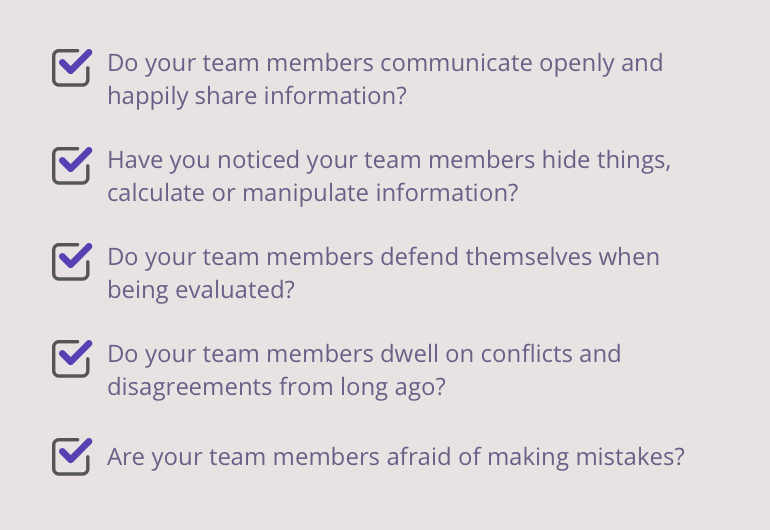
HACK #10: Start an open-door policy
Keeping an open-door policy means that the person in charge leaves the door metaphorically “open” and encourages every employee to communicate with them without reservations. Many companies have reaped the benefits of the open-policy management style such as improved communication, reduced uncertainty, stronger work relationships, better collaboration, and faster problem-solving.
How to do that without sacrificing your own productivity? Set simple rules for everyone. For example:
- If the door to the office is open, feel free to stop by with any work issues. If the door is closed, make an appointment (unless there’s an emergency).
- Before anyone comes to the team lead with a question, they must think it through and prepare answers to the following questions: Who does this issue affect and what are two possible solutions?
HACK #11: Sit near each other
If you can’t walk a mile in your team-mate’s shoes, sitting at a nearby desk is the next best thing. By being near the other team members, you learn about their daily tasks, struggles, and strong traits. You can easily help each other out and you both know what the other is working on without much effort on either side. This type of time-saving makes the team more effective in the long run.

A study held by Thomas Allen, an MIT professor, showed that sitting in close proximity also promotes communication and collaboration.
“/…/ We are four times as likely to communicate regularly with someone sitting six feet away from us as with someone 60 feet away.” – Source
Interestingly, the same goes for digital communication, so don’t rely on staying in touch just by phone or on email, but rather encourage spending time face-to-face with your team. If that’s hard to achieve due to logistics, provide common areas where people meet or schedule regular video calls with remote teams.
HACK #12: Talk openly about the negatives as well as the positives
While it’s not necessary (or necessarily good, even) to be extremely transparent with the outside world, internal transparency and honesty are almost always beneficial. Trust will thrive in a team where the leader is willing to openly discuss the good and the bad sides of the business. Bad news travels fast whether you want it or not, and it can seriously hurt relationships if you try to hide it.

One way to communicate openly is to share real-time data with everyone in the office, for example on a big LCD screen. Another is to address any challenges head-on in a team meeting, providing steps you’re taking to improve the situation if it’s bad.
HACK #13: Choose tools that promote transparency
There’s no doubt that technology has made teamwork faster, easier and more effective. But in some ways, it has also closed off certain information in a bubble – and sometimes it’s a bubble only one person is inhabiting. Email is one of those tools.
Even in 2019, email is where most business begins, but because it’s very individual and typically accessible to one user, it’s not suited for effective teamwork. That’s why it’s important to implement tools in your team that promotes openness, accessibility, and collaboration.
Our collaboration hub, Loop Email was designed with that in mind, so we suggest you give it a try to make your communication on email more transparent and easier to share with your team members. It combines the best of email,
Improving team communication
What is a team without communication? It’s one of the cornerstones of effective teamwork, yet many teams could improve it. Where to start?
HACK #14: Learn the 4 most common communication styles
An efficient team needs clear communication, but not everyone speaks the same language. We’re not talking about bilingual skills, but rather the unique ways your co-workers communicate and collaborate. Communication experts have defined the 4 most common communication styles:
- The Relator
- The Socializer
- The Thinker
- The Director
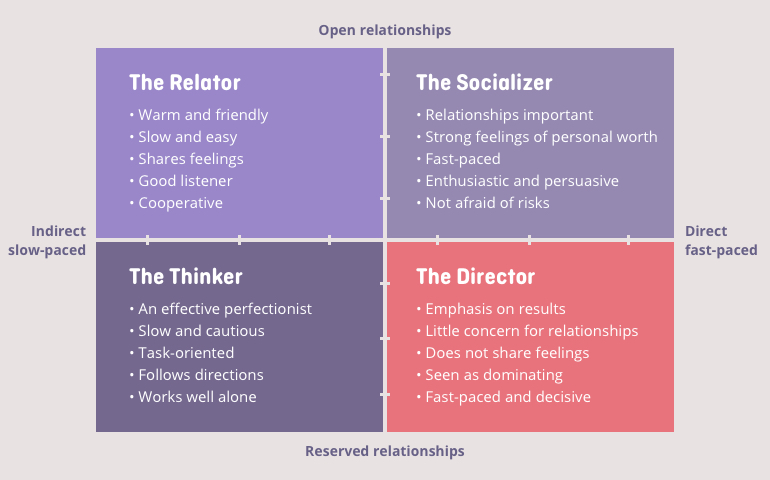
Once you’ve studied the list, can you determine which of your team members express certain qualities and habits? We’re not suggesting pigeonholing them into these four compartments – after all, every person has his or her style, and they can sometimes intertwine. The list is a useful resource to help you understand their strengths and motivations and communicate better within your team.
HACK #15: Communicate and collaborate in one place
It is not just about the whys when it comes to collaborating but also about the hows. We strongly advise you to resist the urge to use too many tools for teamwork collaboration. Keeping track of twenty different apps and platform creates chaos and adds to the stress and effectively makes your team less productive.
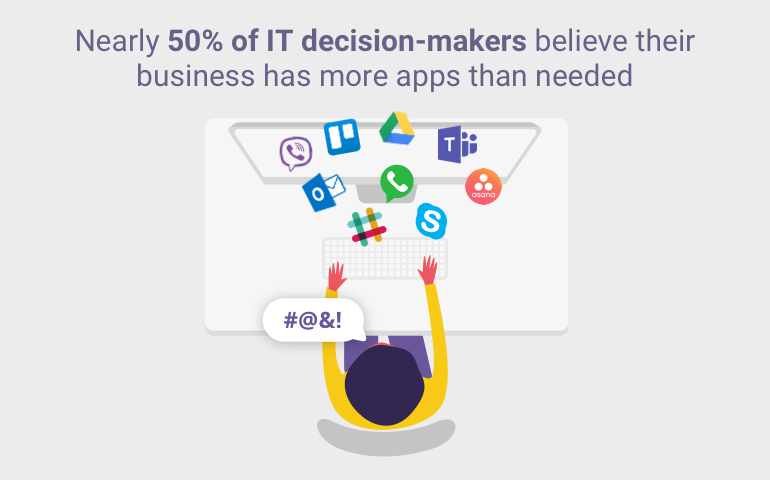
Implement tools and platforms that unite the tools you need inside one platform. One example is Loop Email, a collaboration hub that combines the most common modern business means of communication: email, chat, and (our novel invention) chats around emails. We call the last ones Loops and we believe they can really make a difference in your team communication. See how it’s different from other collaboration apps!
HACK #16: Send meeting agendas upfront
There is one collaboration method that every effective team still needs – good old meetings. Sadly, these are the stats about how people feel about them:
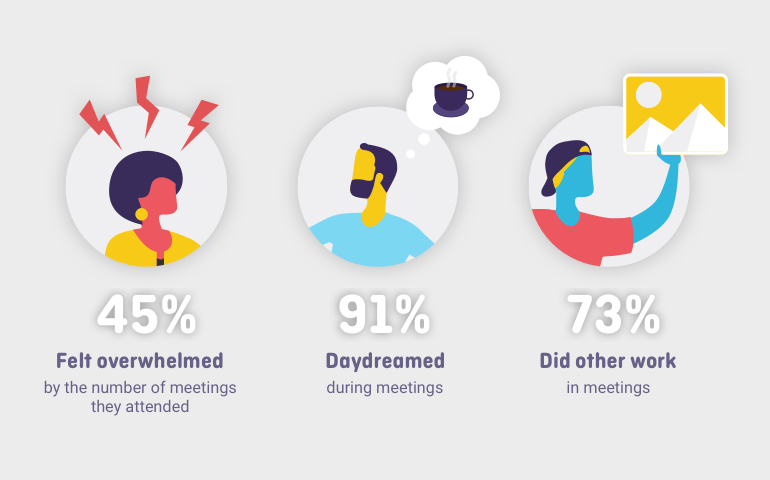
One reason is that most meetings waste a ton of time just aligning the team about the topic of the meeting. The other is that they tend to derail fast if there’s no clear structure. And when we get to the topic, it’s common that people don’t have the answers at hand, so they either go searching for them, or the topic is moved to another, well, meeting.
A way to go about this is to send out the meeting agenda in advance and include a simple request: “Please come prepared with any information regarding the points that concern you.” That way people in your team have already had the time to prepare – pull out data, print out notes or simply refresh their memory.
Read more tips about optimizing your meetings with Loop Email.
HACK #17: Start making daily calls if your team is remote
“As of the beginning of 2020, a full 41% of all global companies offer some kind of remote work opportunities. 60% of global companies provide some kind of “flextime” opportunities that allow workers to choose when to start and end the workday.” – careerswiki.com
Are you working with a remote team? No wonder, the numbers of remote workers have risen in the past years, to the joy (and sometimes also frustration) of many.
One notable downside of remote work is that a lot of human interactions, important for effective teamwork, disappear. That’s why it’s especially important not to neglect your remote team members – and here’s where modern technology comes to the rescue!
Our tip is to introduce daily calls with your remote team into your work routine. Even if the task could be communicated through email, take 5 minutes to check in with the remote worker every once in a while. Effective teamwork is built on all kinds of human communication, including informal. Do some small talk, ask about their week, enforce the feeling of belonging, rather than making them feel like an afterthought.
Building a team culture
Here’s another basic human need – the sense to belong somewhere, whether it’s a family, group of friends, a community or, in our case, a team. Strong leaders address this fundamental need with actions and habits such as mutual respect, a sense of familiarity, and commitments to team decisions and achieve effective teamwork as a result.
HACK #18: Put culture on your walls
Just like primal communities, our sense of belonging thrives under the guidance of rules and beliefs. In our case, we’re not talking about rigid guidelines (although those are necessary for some parts of the process), but rather shared values of the team or the company.
Make those clear in your organization – put it somewhere visible where everyone can see it. Remember the board with the goal and vision? Put the values and beliefs right next to it; it’s just as important.
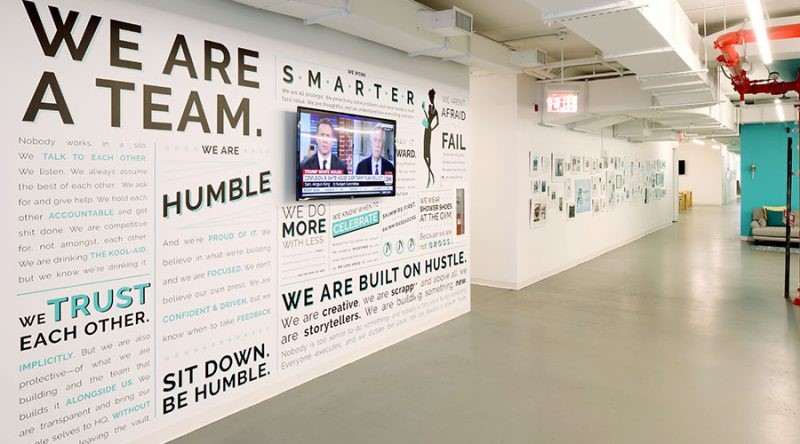
In addition to values, think about stories. Perhaps your company has a strong message to communicate? Here are some great examples of companies that are sharing their culture and values for everyone to see!
HACK #19: Show the new guy some love
Introducing new people to the team is no easy task, and it can rock the balance of the group for a while. But with these hacks, your team can be back on the path to success. The trick is to make the member feel at home and
Effective teams connect on a level that’s more than just work related. They talk about informal topics, share hobbies, and have lunches together.
“At Google, for example, hiring managers are reminded to complete five critical tasks on new hires’ first day. These tasks include having a roles and responsibilities discussion, matching the new hire with a peer buddy, helping the newbie build a social network, setting onboarding check-ins once a month for the first six months, and encouraging continuous open dialogue.” Source
Encourage creativity in the workplace
HACK #20: Give people room to breathe
Being open to new ideas or feedback leads to effective teamwork. Why? Most competent employees do things best on their own, without someone constantly supervising them. It is best if you take the risk and allow them the freedom of letting them do that. Leave micromanagement at the door and let your teammates take matters into their own hands.
HACK #21: Introduce idea boxes to the office
The title is self-explanatory. We love this practice from Toyota:
In 1951, Toyota introduced a principle called the Creative Ideas and Suggestions System in which employees at all levels were encouraged to offer their ideas for improvements in processes or products. That
system, and Toyota’s continued use of its employees to improve its product is credited with being one of the main factors of Toyota’s success. – Toyota’s corporate website
Employee recognition
When you have a hard-working team and a to-do list that’s five pages long, it’s easy to forget an important part of employee motivation: recognition. Salary is not everything, even though an
HACK #22: Reward publicly, criticize privately
Besides situations where a team-member deserves praise, there will also be situations where they need criticism. First of all: if you want to commend someone’s efforts, make sure other people hear it. Secondly, when you’re correcting their behavior, do it discreetly – public humiliation harms employee

HACK #23: Create ways for peer-to-peer praise
Here’s a great example from LinkedIn and their creative way of sharing team recognition:
“This recognition is visible so that all employees of the company are aware and can even interact, comment on, or ‘like.’ Obviously, this award also translates into monetary terms, but I can assure you that the most rewarding thing is not this, it is the feeling that you have done your job well or that you have helped somebody else,”. Source
HACK #24: Measure teamwork in goals not hours
It’s 2019, and we made sure we put the most obvious hack last on purpose. When deciding if an employee deserves a commendation, it’s easy to fall into the trap of “the one who works the hardest.” Don’t value your employee by the number of hours they put in, but by the effect their work has and the goals they have reached.
Above all, achieving effective teamwork is about the results you want to achieve, right?
Did you find our hacks useful? We hope so. Perhaps you even have some bulletproof tricks up your sleeve. If so, we’d love to hear them, so drop them in the comments below or on any of our social media platforms: Facebook, Twitter, or LinkedIn.

















Add comment